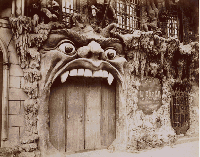French cabaret
From The Art and Popular Culture Encyclopedia

|
Related e |
|
Featured: |
There is evidence of cabarets as early as 1789 in the cahiers de doléances of February 1789.
The first cabaret was opened in 1881 in Montmartre, Paris: Rodolphe Salís's "cabaret artistique." Shortly after it was founded, it was renamed Le Chat Noir (The Black Cat). It became a locale in which up-and-coming cabaret artists could try their new acts in front of their peers before they were acted in front of an audience. The place was a great success, visited by important people of that time such as Alphonse Allais, Jean Richepin, Aristide Bruant, and people from all walks of life: women of high society, tourists, bankers, doctors, journalists, etc. The Chat Noir was a place where they could get away from work. In 1887, the cabaret was closed due to the bad economic situation that made amusements of this kind seem vulgar.
The Moulin Rouge, built in 1889 in the red-light district of Pigalle near Montmartre, is famous for the large red imitation windmill on its roof. Notable performers at the Moulin Rouge included La Goulue, Yvette Guilbert, Jane Avril, Mistinguett, and Le Pétomane. Henri de Toulouse-Lautrec painted numerous pictures and scenes of night life there.
The Folies-Bergère continued to attract a large number of people until the start of the 20th century, even though it was more expensive than other cabarets. People felt comfortable at the cabaret: They did not have to take off their hat, could talk, eat, and smoke when they wanted to, etc. They did not have to stick to the usual rules of society.
At the Folies-Bergère, as in many cafés-concerts, there were a variety of acts: singers, dancers, jugglers, clowns, and sensations such as the Birmane family, all of whom had beards. Audiences were attracted by the danger of the circus acts (sometimes tamers were killed by their lions), but what happened on stage was not the only entertainment. Often patrons watched others, strolled around, and met friends or prostitutes. At the start of the 20th century, as war approached, prices rose further and the cabaret became a place for the rich.
Le Lido, on the Champs-Elysées has been a venue of the finest shows with the most famous names since 1946 including Laurel & Hardy, Shirley MacLaine, Elton John, Marlene Dietrich, and Noel Coward among them.
Famous French cabaret performers:
See also

